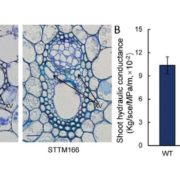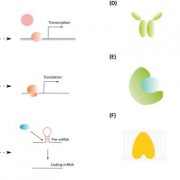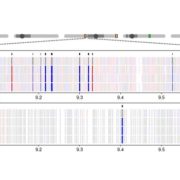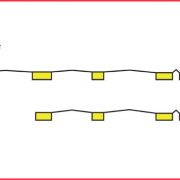Genomic regions of durum wheat involved in water productivity
 Drought stress is a major problem and can cause large reductions in yield. Water productivity is the amount of yield per unit of water used, hence a higher water productivity is associated with more drought tolerance. Here, Zaïm et al. discovered three genomic loci associated with increased water productivity in durum wheat. They grew 384 durum wheat varieties in 18 environments which were classed as ‘moisture-stressed’ or ‘not moisture-stressed’. Using these environmental conditions and yield data, they conducted a genome wide association study (GWAS) and found six loci associated with yield under moisture-stress in multiple environments. To confirm this, the GWAS was repeated with a smaller panel of 80 different wheat varieties grown at two moisture-stressed locations, and three of the same loci, on chromosomes 1B, 2A and 7B, were discovered. The region on chromosome 1B contains a hydroxyproline-rich glycoprotein involved in protecting plants against water loss. The region on chromosome 2A contains transcription factors which could be involved in drought stress response, and the region on chromosome 7B contains genes encoding for aquaporins. All these loci have a positive effect on water productivity and thus positive alleles of these genes could be incorporated into durum wheat breeding programs. (Summary by Rose McNelly @Rose_McN) J Exp. Bot. 10.1093/jxb/erad357
Drought stress is a major problem and can cause large reductions in yield. Water productivity is the amount of yield per unit of water used, hence a higher water productivity is associated with more drought tolerance. Here, Zaïm et al. discovered three genomic loci associated with increased water productivity in durum wheat. They grew 384 durum wheat varieties in 18 environments which were classed as ‘moisture-stressed’ or ‘not moisture-stressed’. Using these environmental conditions and yield data, they conducted a genome wide association study (GWAS) and found six loci associated with yield under moisture-stress in multiple environments. To confirm this, the GWAS was repeated with a smaller panel of 80 different wheat varieties grown at two moisture-stressed locations, and three of the same loci, on chromosomes 1B, 2A and 7B, were discovered. The region on chromosome 1B contains a hydroxyproline-rich glycoprotein involved in protecting plants against water loss. The region on chromosome 2A contains transcription factors which could be involved in drought stress response, and the region on chromosome 7B contains genes encoding for aquaporins. All these loci have a positive effect on water productivity and thus positive alleles of these genes could be incorporated into durum wheat breeding programs. (Summary by Rose McNelly @Rose_McN) J Exp. Bot. 10.1093/jxb/erad357







